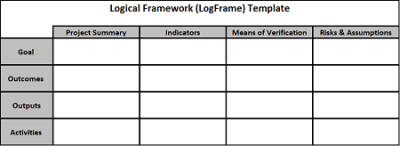Turning Strategy into Action: The Logical Framework
Authored by Terry Schmidt, MBA, PMP, SMP

Does your organization have a great strategy on paper but have trouble making it work in the real world? If so, you’re not alone. In fact, Fortune Magazine has reported that 75% of all strategies fail, largely because of the inability to execute. The fact is that many projects never have a chance. Even the best strategy is worthless unless it’s converted into implementable projects in the hands of capable and committed teams. Most organizations lack a systematic yet flexible way of turning strategic intent into actionable projects, relying instead on ad hoc means or using project management software prematurely.
How you initially plan and start projects will determine how well you can deliver outstanding results. If you design and launch the project wisely at the outset, using the right tools with the right people, you build a strong foundation for success.
An important tool for this is the practical, hands-on Logical Framework. Also known as the LogFrame, it consists of a 4x4 matrix based on a set of interlocking concepts that organize project information in a specific way using standard management terminology. Each cell in the matrix follows the principles of smart management and common sense. The cells interact with each other, and changes in one can affect the others, reflecting the dynamics of our mental models and thinking process. The completed matrix communicates a complicated project clearly and understandably on a single sheet of paper.
The LogFrame helps you answer four critical questions. These four questions provide an intuitive, jargon-free way to develop sound projects.
- What are we trying to accomplish and why?
- How will we measure success?
- What other conditions must exist?
- How do we get there?
The LogFrame elegantly incorporates answers to the standard “interrogative questions.” Goal is the big-picture program why, the rationale for this and related projects. Purpose is the project-specific why, the reason for this effort. Outcomes are the what that we must produce. Inputs capture the how, who, and when.

True synergy occurs when teams use this tool to collaborate. The LogFrame builds shared understanding, promotes communication, and increases trust. Its common logic and standard vocabulary help teams start faster and execute projects that deliver results. These tools aren’t magic; their power comes from forcing you to ask the right questions. Getting the right answers, however, works real strategic magic! Here are some additional ideas for applying this method.
Develop or Update the Strategic Plan.
This method supports a broader strategic planning process. Regardless of the context in which you operate, at least annually, you should review and refine your strategic portfolio. Prioritize your strategies and create LogFrame plans for the top ones.
Strengthen Teams across Work Functions.
The LogFrame tool helps bring together new teams and taskforces. The questions and matrix provide a common vocabulary to integrate cross-functional players around common objectives, and enables them to work smoothly across organizational boundaries.
Reinvent Your Department.
From time to time, take a fresh look at where you are and where you need to go, and then develop LogFrame strategies to get there. When performance levels lag, or your mission changes, this becomes more vital than ever.
Develop Information Technology Solutions and Algorithms.
The LogFrame serves as a general-purpose analytic tool that helps to define algorithms of every sort, and integrates technology solutions within core processes.
Develop Recommendations and Make Decisions.
Use this tool to be systematic and transparent about how to set decision criteria, identify alternatives, collect information, conduct the analysis, and make recommendations.
Unstick Stuck Stuff.
Take a fresh look at stalled projects, programs, and strategies; identify and evaluate alternatives; and redirect your effort along promising directions. Break loose by brainstorming fresh purpose statements and see what new patterns emerge.
By using the LogFrame approach, you’ll build a strong strategic foundation that leads to predictable success.
Identify your path to CFO success by taking our CFO Readiness Assessmentᵀᴹ.
Become a Member today and get 30% off on-demand courses and tools!
For the most up to date and relevant accounting, finance, treasury and leadership headlines all in one place subscribe to The Balanced Digest.
Follow us on Linkedin!
